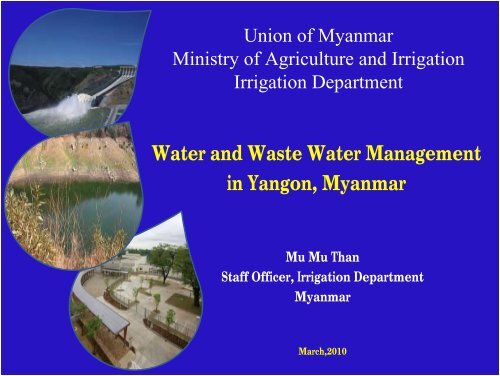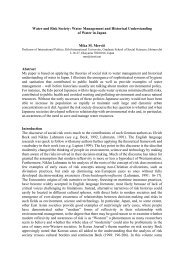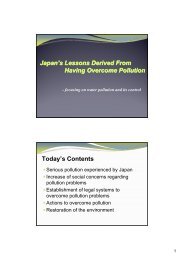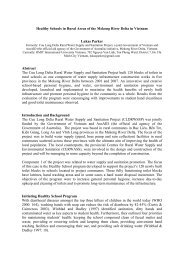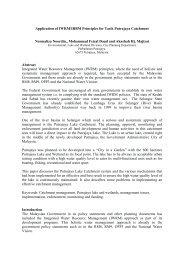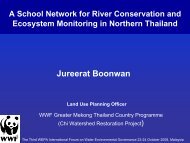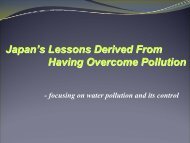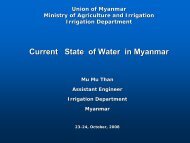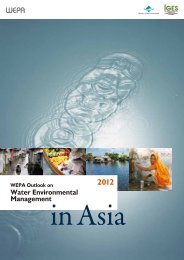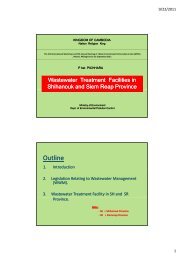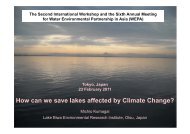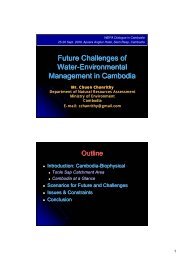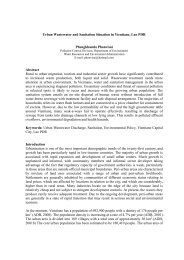PDF: 478KB - WEPA
PDF: 478KB - WEPA
PDF: 478KB - WEPA
Create successful ePaper yourself
Turn your PDF publications into a flip-book with our unique Google optimized e-Paper software.
Union of MyanmarMinistry of Agriculture and IrrigationIrrigation DepartmentWater and Waste Water Managementin Yangon, MyanmarMu Mu ThanStaff Officer, Irrigation DepartmentMyanmarMarch,2010
Socio-economical and naturalcondition of YangonYangonFormer capitalcityArea10,170 km²Population5.56 million 2000‐20016.32 million 2009‐2010(11 % of the total population)Annual averageprecipitation2550 mm
Programme for access to save drinking water( MMDG)1990 2000Urban Rural Total Urban Rural Total38% 30% 32% 89% 66% 72%
Water Supply• Daily about 511030 m³/d are supposedly suppliedto around 60 percent of the populationWastewater Treatment• The plant treats 12,300 m³/d of sewage from 6townships in the downtown area which is forpopulation of about 325,000.
Situation of quantity and quality of the water sourcesNameVolume ofavailablewater(m³)Volume ofabstracted water(m³)Water QualitySurface waterGyobyu Reservoir102,206 m³/dwithin the highestdesirable levelPhyugyi Reservoir andHlawga Reservoir219,553 m³/d within the highestdesirable levelNgamoeyeik Reservoir 170,343 m³/d within the highestdesirable levelSurface waterLower AyeyarwadyRiver BasinGround waterAlluvial, IrrawaddianPeguan8,5800 m³/yr153,249 m³/yr
Ground Water Quality• Most common tests conducted usually are on color, turbidity,pH, hardness, iron and chlorideIron Concentration• Evaluation on the chemical quality on tube wells in 17townships Eastern Yangon indicates that about 34% of thewells tested have iron content in excess of 1.0 mg/lChloride• The presence of chloride concentration of more than 2000mg/l may be attributed to the sea water intrusion sincepermeable formation outcrops are found along the bank of theYangon River.
Water Quality StandardHighest DescribeLevelMaximum PermissibleLevelAppearanceOdorColour (Platinum Cobalt Scale) 5 Unit 50 UnitTurbidity (Silica Scale Unit) 5 NTU 25 NTUpH value 7.0 to 8.5 6.5 to 9.2Total Solid p.pm(mg/l) 500 mg/l 1500 mg/lTotal Hardness(as CaCO3) 100 mg/l 500 mg/lTotal Alkalinity(as CaCO3)Calcium as Ca 75 mg/l 200 mg/lMagnesium as Mg 30 mg/l 150 mg/lChloride as C1 200 mg/l 600 mg/lSulphate as SO4 200 mg/l 400mg/lTotal Iron as Fe 0.3 mg/l 1.0 mg/lLead 0.05 mg/l 0.05 mg/lOthers
Effluent QualityStandardPollutant or parameterLimitpH9-JunBOD 50COD 250Oil and grease 10TSS 50MetalsHeavy metals, total 10Arsenic 0.1Cadmium 0.1ChromiumHexavalent 0.1Total 0.5Copper 0.5Iron 3.5Lead 0.1Mercury 0.01Nickel 0.5Selenium 0.1Silver 0.5Zinc 2CyanideFree 0.1Total 1Ammonia 10Fluoride 20Chlorine, total residual 0.2Phenols 0.5Phosphorus 2Sulfide 1Coliform bacteria
Yangon City Development Committee WasteWater Treatment PlantOperating periodIanuary,2005Waste water ‐ Domesticcharacteristic WasteWaterTreatment process ‐ Activated sludge process with theintermittent aeration systemDaily amount of treatedwastewaterDesign‐ 12,300 m³/day
‐ In sub‐urban areas of Yangon City individual septic tanksare constructed for homes in accordance with YCDC standards.‐ Digested sludge accumulated in the tank is desludged byvacuum tankers of the YCDC or request with service chargesmade on the amount of volume desludged.
Water Quality Protection• ‐ To control the direct discharge of wastewater fromfactories into rivers and streams( NCEA proposed effluent standards for proper disposal )• To ban the use of some toxic pesticides and encourage theutilization of conventional bio‐ fertilizers as a substitute forchemical fertilizers(MAS, Ministry of Agriculture and Irrigation)
• Arsenic and other parameters have been tested incollaboration with the Water Resources UtilizationDepartment ( WRUD), Department of Development Affairs( DDA) and United Nations Children’s Fund( UNICEF). TheEnvironmental and Sanitation Division under the Ministry ofHealth is implementing a programme on water supplysystems with health institutions and also carrying out a WaterQuality Surveillance and Monitoring System Pilot Project inYangon.
Water Quality Testing• Reservoirs ‐ Irrigation Department• Ground water ‐ YCDC• Rivers ‐ Department of Meteorologyand Hydrology
Development of Water Supply andSanitation Facilities(i)(ii)(iii)Incorporate sewage concerns when formulatinghuman settlement plans;Build and maintain sewage treatment facilitiesand other appropriate disposal systems inaccordance with national policies andcapabilities;Locate coastal outfalls so as to maintain anacceptable level of environmental quality and toavoid exposing communities and marineresources to pathogens;
Continuous(iv)(v)(vi)Promote environmentally sound combinedtreatment of domestic and compatible industrialeffluents;Promote primary treatment of municipal sewagedischarged into rivers, estuaries and the sea;Establish and improve regulatory and monitoringprogrammes to control effluent discharge, usingminimum sewage effluent guidelines and waterquality criteria.
ConclusionThere are many water related sub‐sectors in Myanmarsuch as irrigation and drainage, water for environment andecosystems, drinking water and water utilization forindustries and sanitation. These should be integrated toexchange views and promote understanding of the qualityand quantity of water use and the value of water in the socialsector and exchange of views.Nevertheless, the Environmental Impact Assessment isstill weak in water resources management. Due to theongoing rapid industrialization in cities, these are so manyfactories around urbanized areas, and there is still a need todisseminate the knowledge about the proper disposal ofwastewater to control the problems of the direct dischargeof wastewater from factories into rivers or streams
continuousOther weaknesses in water environment managementare a lack of appropriate monitoring facilities, proper andsystematic keeping of records, regular monitoring andsurveillance data for water quality control and basicsstandards of water quality for drinking water.Although there are many laws, acts, legislations andregulations related to water sector, most laws and acts forwater sectors still need to be modified. Therefore, these lawsand regulations should be reviewed to enact unified waterresources laws to promote a more effective legal frameworkfor coordination and management of water resources.


